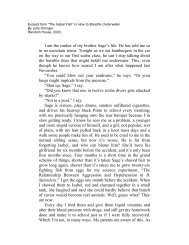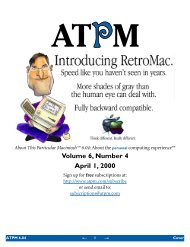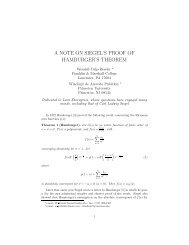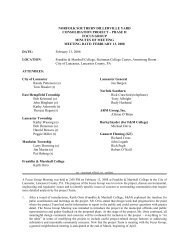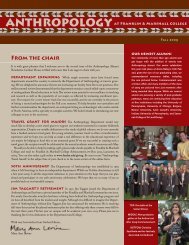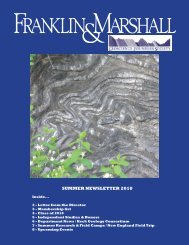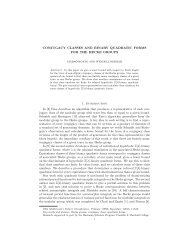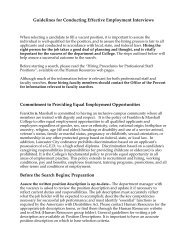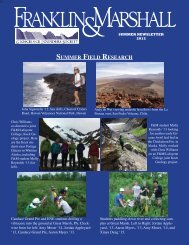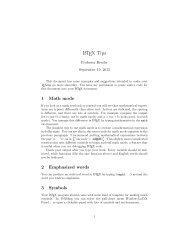Department of Earth & Environment - eDisk - Franklin & Marshall ...
Department of Earth & Environment - eDisk - Franklin & Marshall ...
Department of Earth & Environment - eDisk - Franklin & Marshall ...
- No tags were found...
Create successful ePaper yourself
Turn your PDF publications into a flip-book with our unique Google optimized e-Paper software.
December 2011 <strong>Department</strong> <strong>of</strong> <strong>Earth</strong> & <strong>Environment</strong> Page 9Research HighlightsElvis Andino ‘12 / Jordan Appleyard ‘13 / Peter Rippberger ‘12A Controlled Freeze-Thaw Experiment to Model Erosion <strong>of</strong> Stream Bank SedimentsRecent studies by F&M students and faculty suggest that needle ice formation along streambanks is a primary process by which sediment is eroded to surface waters. The purpose <strong>of</strong> thisstudy was to construct a laboratory experiment to identify the physical parameters under whichneedle ice forms, and to quantify the amount <strong>of</strong> sediment eroded due to freeezing and thawingprocesses. We used time-lapse photography and in situ soil moisture and temperature sensorsto derive the conditions necessary for needle ice growth. We measured the mass <strong>of</strong> sedimentlost upon thawing, and calculated the volume per area <strong>of</strong> sediment eroded by this process.JordanOur laboratory apparatus created a freezing front analogous to that observed in stream bankAppleyardsediments during the winter. Using data from six freeze-thaw cycles, we extrapolate our results to show that bankerosion by freeze-thaw processes can account for the entire suspended sediment load on the watershed studied.This project made possible by funding from F&M’s Committee on Grants.Project Adviser: Bob WalterPeter Rippberger ‘12 / Elvis Andino ‘12 / Jordan Appleyard ‘13Nutrient Release from Stream Bank Sediments: The Effects <strong>of</strong>Physical and Chemical Weathering <strong>of</strong> Stream Bank Sedimentson Nutrient SolubilityThe objective <strong>of</strong> this research was to recreate needle ice formation in stream banks using an experimental apparatusdesigned and built by our research group during the summer <strong>of</strong> 2011. The purpose <strong>of</strong> this study was tomeasure nitrate (NO 3) and orthophosphate (PO 4) mobility between soil and pore water (needle ice) before andafter multiple freeze-thaw cycles. Previous research suggested relatively high concentrations <strong>of</strong> nitrates in theneedle ice in the natural environment (Zhao 2010). Our results indicate that needle ice mobilizes phosphorus aswell, as the concentration <strong>of</strong> P lost from the soil after a freeze-thaw cycle closely correlates with that gained inthe needle ice. We hypothesize that freeze-thaw processes weaken orthophosphate bonds on particle surfacesmaking it available for pore water uptake. This work shows that freeze-thaw processes during the winter searsoncould be an important source <strong>of</strong> soluble nutrients to surface water in the region.This project made possible by funding from F&M’s Hackman Summer Scholars Program.Project Adviser: Bob WalterEvan Anway ‘13Calcium Carbonate Concretions in the Sedimentary Record and theirPaleoclimatic SignificanceLarge deposits <strong>of</strong> calcium carbonate concretions occur along the base <strong>of</strong>stream banks along Little Conestoga Creek, PA. Concretions are uncommonin streams, and typically occur in association with lake margins. The primarygoals <strong>of</strong> this project were to determine how and when these concretionsformed, and to reconstruct the environment in which they formed. Theseconcretions likely formed from algal deposits on quartz cobbles. Shell andnut samples collected from the stratagraphic column both above and belowthe concretion layer were dated in order to determine the time <strong>of</strong> concretionformation. Freshwater gastropod shells and paleo-seeds were collected from the column as well in order to reconstructthe ecology <strong>of</strong> the area before and after the concretions formed.This project was made possible by funding from the Mellon Scholars Program.Project Adviser: Rob Sternberg




